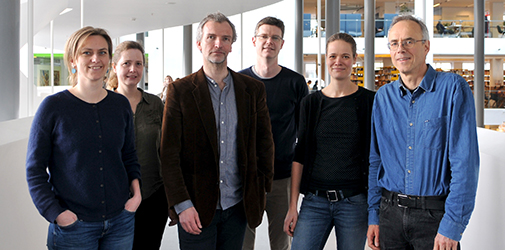A dyslexia test for all school levels
In 2012, the Danish Ministry of Education commissioned researchers at the Centre for Reading Research (University of Copenhagen) and the Danish School of Education (DPU, Aarhus University) to develop a national dyslexia test for all students from grade 3 through university levels. Launched in 2015, the test is now used by all 98 local authorities in Denmark and at all levels of the educational system. Identifying dyslexia earlier enhances educational opportunities and helps prevent social problems.

Centre for Reading Research
In 2012, the Danish Ministry of Education commissioned researchers at the Centre for Reading Research (University of Copenhagen) and the Danish School of Education (DPU, Aarhus University) to develop a national dyslexia test for all students from grade 3 through university levels. Launched in 2015, the test is now used by all 98 local authorities in Denmark and at all levels of the educational system. Identifying dyslexia earlier enhances educational opportunities and helps prevent social problems.
It is estimated that around 3–7% of the population of Denmark is dyslexic. The earlier the condition is discovered, the greater the chances of a targeted intervention making a difference. Providing students with dyslexia with the support they need at school enhances their educational opportunities and helps prevent social problems.
The characteristics of people with reading difficulties is one of the subjects studied by the Centre for Reading Research. Reading makes use of two different skills: the ability to recognise individual words based on our knowledge of the letters of the alphabet and their sounds (decoding); and our more general understanding of language, e.g. vocabulary, sentence structure and the ability to use prior knowledge to interpret texts.
Commissioned by the Ministry of Education
In 2012, the Ministry of Education commissioned the Centre for Reading Research and DPU to develop a national, wide range dyslexia test for students from grade 3 through university levels. The idea was to enable teachers to use the same test for students of all ages throughout the education system to facilitate smooth transitions and to provide a uniform and operational understanding of dyslexia across institutions.
Signs of dyslexia
Dyslexia is associated with difficulty with word decoding, that is identifying words by recognizing and combining letter sounds, rather than difficulty understanding the meanings of words. For example, someone with dyslexia will have difficulty reading a nonsense word like “tok” out loud. Dyslexia is the term used when no other obvious reading problem is apparent, for example visual or hearing impairment, poor language skills in general or brain damage.
The Centre for Reading Research conducted trial runs of parts of the test on a large number of children in different age groups. The idea was to find out what types of tests are best suited to identifying difficulties with word decoding.
Impact
The Ministry of Education launched the national wide-range dyslexia test in February 2015. It was developed jointly by the Ministry, the National Board of Social Services and the School Research Programme, DPU, Aarhus University. Teachers from primary and secondary schools, as well as higher-education institutions, worked alongside the researchers on trials and evaluations of the test.
In May 2016, a survey by the National Agency for IT and Learning showed that all 98 local authorities in Denmark are now using the test.
Barrier to education removed
Before the test was introduced, primary schools had no standard procedure for identifying dyslexia. As a result, students faced unnecessary barriers throughout the educational system. They were examined in different ways, and some of them struggled to have their dyslexia recognised.
The new test provides a more reliable and standardised method of identifying dyslexia, throughout Denmark and the education system. Students no longer need to take multiple tests for dyslexia at different ages. The test also facilitates transitions between different study programmes.
The test is not an end in itself – simply identifying dyslexia is not enough. Acknowledging dyslexia is, however, the key to meeting the needs of students with dyslexia, both at school and throughout their education, and to giving them the best possible foundation for their working life and adulthood.
Further information
Centre for Reading Research, University of Copenhagen
Ministry of Education website about the dyslexia test
Contribution to the BDA International Conference, Oxford, UK, on 12 March 2016: The Danish Dyslexia Test. Validity of a wide-range, web-based test for dyslexia
Contact
Carsten Elbro
Professor
ce@hum.ku.dk
Tel. +45 35 32 86 56
Anne-Mette Veber Nielsen
Postdoc
mhn385@hum.ku.dk
Tel. +45 35 32 86 69
Hanne Trebbien Daugaard
Postdoc
trebbien@hum.ku.dk
Tel. +45 35 32 83 89
Anna Steenberg Gellert
Associate Professor
agellert@hum.ku.dk
Tel. +45 35 32 81 66
Holger Juul
Associate Professor
juul@hum.ku.dk
Tel. +45 35 32 91 32
Mads Poulsen
Associate Professor
m.poulsen@hum.ku.dk
Tel. +45 35 32 91 31
